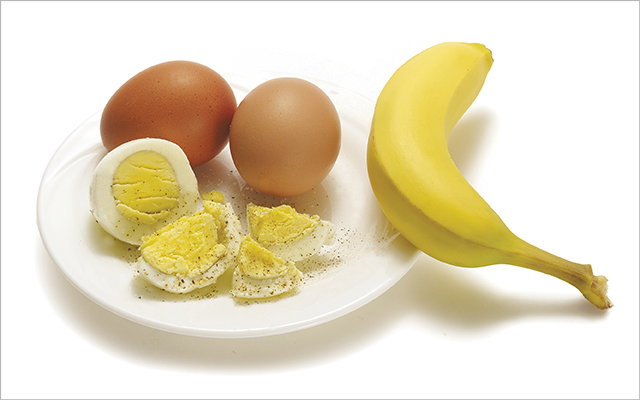Caffeine and Your Workout ⋅ Fixing Hand Calluses ⋅ Beginner Tabata
Q1: Caffeine
My trainer claims drinking a venti cup of coffee before he hits the gym helps him work out longer and harder, but my nutritionist cautions against heavy caffeine use. Is this something I should try?
A: Both pros have a point. Regular, heavy caffeine use can — especially if you hit the coffeemaker multiple times a day — increase your body’s levels of the stress hormone cortisol, tuckering out your adrenal glands, messing with your metabolism and increasing your blood pressure.
Still, despite your trainer’s highly questionable use of the word “venti” in casual conversation, his assertion is not entirely without merit. There’s plenty of research that demonstrates caffeine can improve performance in both strength and endurance endeavors.
Assuming you’re interested in wielding caffeine as an athletic performance booster, the trick is figuring out how and when to wield your cup. The general recommendation is about 6 mg per kilogram of body weight — 8 if you’re a regular caffeine user and thus less sensitive to its effects — 30 minutes prior to exertion. But everyone responds differently, so dosage depends on the individual.
Lonnie Lowery, PhD, exercise physiologist, sports nutritionist and founder of www.IronRadio.org, broke it down for me this way: “For a typical 175-pound male, the guidelines would suggest a whopping 480 milligrams of caffeine. That’s about two-and-a-half caffeine tablets or at least three packets of instant coffee.” This dose has led to increased maximum strength and reduced perception of exertion during exercise, he says, but he considers it far too high for caffeine-sensitive people such as himself.
I’m (shaking) in Lowery’s corner on this one. After reading some research on the positive effects high dosages of caffeine (particularly in pill form) can have on performance, I followed the recommendations for a 145-pound female and popped a couple NoDoz a half-hour before a rugby game. By halftime, I could think of nothing but the shooting pains in my abdomen, and I spent several hours after the final whistle curled in the fetal position. So while I did put on quite a performance, it wasn’t the type I was looking for. (I stuck to coffee after that.)
My take: Caffeine supplementation isn’t a good long-term strategy for building fitness, but it might be worth experimenting with as an occasional performance booster. But take heed: The first time to try it is not on the day of a big event.
Q2: Calluses
I’m psyched about the changes I see in my body from lifting weights, but somewhat less psyched about the calluses I’m getting on the palms of my hands. How do I fix them?
A: You’re not alone. Calluses — and callus care — seem to be all my gym buddies and I talk about. For those of us into lifting weights, those thick, hard deposits of dead skin are a fact of life.
Personally, I’ve always considered them a small tradeoff for the many health benefits of weightlifting — better energy, more power, a better blood profile, sexy muscles! And not so very long ago, I would have encouraged you to wear your calluses like a badge of honor — because, girl, you earned them! But then, horrifyingly, I ripped one completely off while learning to do kipping pull-ups. After that, I went in search of some callus-care advice myself.
First, and most obviously, if you want to avoid calluses, you can try a pair of gymSkins (www.gymskins.com) or weightlifting gloves. But be warned: If your workout partners are anything like mine, you might take some ribbing for being “soft.”
To keep my hands — and my pride — intact, I sought the callus counsel of one of the strongest women I know: Pamela MacElree, creator of the Kettlebell Training for Women DVD and co-owner of Urban Athlete in Philadelphia, Pa. This is the approach she recommends: Twice a week, several days apart, rub a natural pumice stone on your calluses after you get out of the shower, or use a PedEgg to shave them down. Next, use an emery board to file them smooth and apply cocoa butter or another heavy moisturizer afterward.
In retrospect, the solution seems obvious. Then again, I guess the notion of shaving my palms had never occurred to me. In any case, I’m happy to report that my calluses are back to barely noticeable.
Q3: Tabata
I stumbled across the article “The Tabata Tune-Up,” and while I like the idea of a short, super-intense workout, here’s the thing: I’m probably a hundred pounds overweight right now. Is this workout feasible for me?
A: I applaud your grit! And your question is a wise one, because when it comes to shedding unwanted weight, interval training reigns supreme. But you might not be ready for a full-fledged Tabata workout just yet. What makes the Tabata Protocol, in particular, so effective is its maximal effort level and minimal rest time. It consists of eight total cycles of alternately working as hard as you possibly can for 20 seconds and resting for 10 seconds, adding up to a four-minute-long workout.
That may not sound like much, but the go-all-out factor triggers quick and certain changes in your body. Unfortunately, that same go-all-out factor can put it out of reach for those who are detrained or carrying a lot of extra weight.
Most personal trainers would recommend you build a fitness base first and gradually work up to more intense interval training. But then there are those who argue in favor of a scalable, easier version of Tabata right from the start, regardless of your current level of conditioning — with the usual stipulation that you check with your doc first.
Angie Brambley, assistant varsity strength-and-conditioning coach at Princeton University, is a member of the latter group: “Trainers talk about submaximal Tabata intervals not being ‘true’ Tabata, but who cares? You don’t want to go so hard at first that you never return to the gym.”
In Brambley’s view, scaled-back Tabata cardio workouts are a great way to progress toward the real deal. So pick any piece of cardio equipment (if you’re carrying extra weight, select something low impact, such as a stationary bike, elliptical trainer or rowing erg) and do your best-effort version of Tabata. If you feel like you’ve got more to give after your first four minutes, choose a different piece of equipment and do a second round.
As you get used to working outside your comfort zone, increase your intensity. It may take a good month or so before you’re ready to push harder, and that’s fine — consistency is the most important factor. Once you’re putting forth what you perceive to be your maximal effort, you’ll be doing true Tabata and getting major results in minimal time.





This Post Has 0 Comments